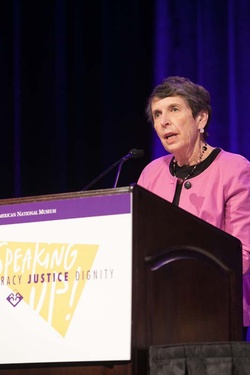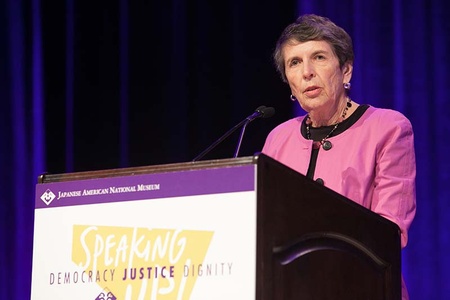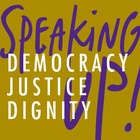I am honored to have been asked to speak to you this morning. I accepted your invitation in a heartbeat because this celebration is important to me. As you know, I became a student of the “internment,” albeit inadvertently, as a result of Gordon Hirabayashi’s court case in the 1980s seeking to overturn his wartime conviction for violating “internment” orders. We gathered here in Seattle a year and a half ago to celebrate the 25th anniversary of our court’s opinion in that case, and I’d like to think that our court’s opinion, along with Judge Marilyn Patel’s decision in Korematsu, helped make possible the passage of the Civil Liberties Act in 1988. How fortunate it is that both men lived to receive some personal vindication from those court decisions and to observe that eventually, and remarkably, even Congress saw the light.
I have, of course, a secondary motivation for instantly accepting your invitation, and it is that I am from Phoenix and it is July, and Phoenix judges always come to Seattle at the drop of a hat in the summer. The first time I heard cases in Seattle was in the summer of 1981, as a young court of appeals judge. I was amazed to find that all of our Phoenix district court judges were sitting in Seattle, but I was not so surprised in February when all the Seattle judges turned up in Arizona. Things were a lot simpler for judicial travel in some ways 30 years ago, because all the district judges were men and most had wives with grown children and without independent careers, so judges were a lot more cavalier in those days about leaving home for months at a time.
When I came to Seattle in 1981 however, I came with my husband and two daughters, ages 9 and 3. One of my colleagues had arranged accommodations for us at the Washington Athletic Club, but while I was in court my husband was unable to take the children to lunch there because the dining room would not serve females. My husband was really mad. It was the first time he, or our daughters, had ever experienced gender discrimination first hand.
I tell this little story only to illustrate how times change. This is an anniversary we are celebrating today, and anniversaries are about change. We all experience change, of course, but only exceptional people bring it about, and truly great people change the country to make it a better place. Gordon Hirabayashi and Fred Korematsu were truly great people.
What we are commemorating today is, in fact, the change that has occurred from the dark days of early World War II through today, change punctuated by the enactment of the Civil Liberties Act embodying the extraordinary recognition by the congress of the United States that this country had made a terrible mistake. I learned a long time ago that if you want people to understand what is really important and why it is important, you have to (as they say on capitol hill) “put a face on it.” So that’s what I am going to do today. I am going to put a face, or more accurately three faces, on the changes that have occurred, for the better, since the WWII era. I am going to do that by telling you about three great judges who helped bring about those changes. The story of each of these men began in pre-WWII racism and culminated some three to four decades later in their nomination by the president of the United States to federal judgeships. Thus all the stories begin when these men, as children, experienced the effects of racism and they conclude with triumphant careers fighting for the values of our Constitution.
The moral of all of these men’s stories is really a fall and rise of the U.S. Constitution. By now history has come to see that the “internment,” in a sense, made the Constitution one of its victims. In fact, that is exactly how Gordon Hirabayashi saw it. While he was fighting in the 1980s to overturn his wartime convictions, he said about the “internment” that “our Constitution was reduced to a scrap of paper.”
Then, after he thought about it a little more deeply, and the Civil Liberties Act became a reality, he concluded “it wasn’t necessarily the Constitution that failed me. It was the people who were placed in the responsibility of upholding the Constitution.” And, of course, he was, in a sense, right both times. The U.S. Constitution is nothing but a piece of paper unless Americans are willing to fight for the rights that it says that it guarantees. That means people like Gordon Hirabayashi and Fred Korematsu, who fight to vindicate constitutional wrongs, and it means judges who must stand up to recognize them.
One of the most significant things about the Civil Liberties Act to me is that it is not simply a declaration of “mea culpa” for past history; it is an effort to make at least some amends to those people who actually suffered that wrong. If you haven’t got the idea by now, I will say it again, and that is that it’s all about people.
So I am going to talk to you about three Asian American judges and their amazing stories. Two of them have passed away, but one is still a judge, and a most courageous one. The first, Tom Tang, was a Chinese American from Arizona, the second, Herbert Y.C. Choy, was a Korean American judge in Honolulu, and the third, A. Wallace Tashima, my current and beloved colleague, a judge with Japanese ancestry now living in Los Angeles.
First I will tell you about the late, great Thomas Tang. His life represented a series of triumphs over prejudice and ignorance. Tom grew up in the ‘40s in Phoenix, which was then a segregated community. Chinatown was located in a small area now occupied by the U.S. Airways center, home of the Phoenix Suns. Tom’s family felt the effects of the Chinese exclusion act and could not bring family members from China to the United States. His father established a night school for Chinese American children in Phoenix to preserve the Cantonese language in Arizona.
Young Chinese Americans in Phoenix, like Tom, were not black, and so they attended the high school for white students rather than the segregated school for blacks. But the Chinese Americans were not white either, so they could not swim in the public swimming pools reserved for whites only. It is now hard to imagine.
Tom earned university and law school degrees in Arizona, practiced law, and was a member of the Phoenix City Council and vice mayor of Phoenix before he became a state court judge in 1963. He left that bench in 1970, but not voluntarily. He was defeated for reelection because of a highly publicized case: a case involving two juveniles who committed a violent act. The newspapers howled for vengeance. Tom instead sentenced the two to probation, refusing to buckle under to the pressure of publicity to do something Tom considered unjust. His decision was upheld by the Arizona Supreme Court and by history. Tom was fond of telling his friends privately that one of the youths involved later grew up to become a police officer. But Tom was defeated in the 1970 contested judicial election, because of that “too lenient” sentencing and perhaps a bit of racial bias, so a lot of the responsible people in the community were outraged. Leading citizens protested judicial elections where persons could run against—and attack sitting judges. The outrage was so great that Judge Tang’s election defeat actually became the catalyst to bring about merit selection in most of our Arizona courts. Tom was further vindicated eight years later when President Carter appointed him to the U.S. Ninth Circuit Court amidst great public acclamation, and where he served with distinction for eighteen years before his untimely death in 1995. Tom rose above racism and changed Arizona history.
Second, I will tell you about Judge Herbert Choy of Hawaii, the next to the last territorial attorney general of Hawaii, the first Hawaiian to sit on the Ninth Circuit Court of Appeals, and the first Korean American to become a federal judge.
After his death, I went to Honolulu to make arrangements for the preservation of his papers. I came across a copy of a speech he made at the Harvard Law School in 1991, the year of the 50th anniversary of his graduation. The title of the speech is “me.” It tells about his many journeys through a career of public service marked by absolute dedication and integrity: his journey from Honolulu to Harvard in 1938; his military experience in World War II; the practice of law and service in high governmental posts. In all of those journeys, he blazed a trail for lawyers from all ethnic backgrounds to follow. Herb was the son of a sugar cane cutter in Kauai who made good. This is how he describes his birth:
“I was born in the sugar plantation hamlet of Makaweli, Kauai, Territory of Hawaii on January 6, 1916. My mother recalled that I came into the world at 6 a.m., just as the plantation mill whistle blew heralding a new work day. My parents were both born in Korea. Their parents, my grandparents, came to Hawaii as sugar plantation contract laborers bringing their children with them…”
Judge Choy’s father was thus raised as a sugar cane cutter, close to slavery, and with very little schooling. But he learned to read and that was all he needed. One day he found a matchbook cover on the beach that advertised a correspondence school to become a tailor. He sent for the course, took it, and at 18 began to sew and sell clothing. Judge Choy’s memoirs describe him in the following passage:
“My father was a remarkable person. At 18, he began business as a ‘merchant-tailor’ as he styled himself. Besides clothing, he sold miscellaneous items of jewelry and personal adornments to plantation laborers. I have in my office his 1917 diploma from the Cybick school of garment cutting and designing in New York City. I marvel at his ability to complete correspondence courses with only 4th grade schooling…”
I have seen the diploma personally and know that the lesson learned from his father by Judge Choy was education. Judge Choy wrote:
“Although my father left school at an early age to help his family as a plantation laborer, he had a firm belief in education which he realized vicariously through his siblings, his children, and the children of his brother, all of whose schooling he subsidized. ‘You must have education’ was his constant reminder to us.”
Judge Choy goes on to describe his father’s moving the family to the island of Oahu to go into the military uniform business in 1921 where, with the growth of the military in the ‘30s, the business thrived.
The business was so successful that Judge Choy’s father purchased the parcel of land on Waikiki where his tailor shop was located, and the land across the street. That land turned out to be valuable and today is the huge office and retail complex called Discovery Bay. When I went through Judge Choy’s papers with my Honolulu colleague, Judge Rick Clifton (who was a Choy law clerk), we found the original fee simple deed to that parcel. Land is scarce in Honolulu, and most is owned by family trusts. My colleague, who practiced in Honolulu for many years, had almost never seen a fee simple deed in the islands and when he saw this one, he went into a state of near shock.
Blessed with incredible talent, perseverance, and belief in education, Judge Choy’s father, born a sugar cane cutter in near slavery, was able to send his first-born son to Harvard Law School in 1938. As I recall, in the picture of his Harvard Law School class, he is near the center, the only face of color in a group destined for wartime heroism and post-war success.
Judge Choy’s memoirs take him through his law school career, his return to Honolulu, and passing the bar examination just in time for enlistment in the army on December 7, 1941. His post-war career began in practice in Honolulu where he joined the first Korean-American, Chinese American law firm with the soon-to-be Senator Fong, and Judge Choy was eventually appointed territorial attorney general. He was very handsome and known as the most athletic of Hawaii’s officials. A photograph of the surfing attorney general riding a wave became legendary. When it was time for Hawaii as a state to have its first appointment to the Ninth Circuit Court of Appeals, Herb was a natural. As a judge he was a great mentor who never forgot that he was the son of a sugar cane cutter on Kauai, and who was part of the great post-WWII forces of change.
The third judge, A. Wallace Tashima, is a treasured friend. Wally was born in California in the early 1930s, an American citizen proud of his Japanese heritage. After the bombing of Pearl Harbor by Japan in 1941, at the age of eight, Wally and his family were uprooted from their home to be incarcerated in a camp in the middle of the Arizona desert for the duration of World War II. When they returned to California, they had to begin all over again.
Many of us would have become alienated from our country’s government by such an experience, but Wally went on to serve it with great honor and distinction. He was a deputy state attorney general and partner in an illustrious law firm before being appointed to the district court by President Jimmy Carter and to the court of appeals by President Bill Clinton. Clearly the internment experience shaped his life and career. In an interview about 10 years ago he looked back on that experience in light of the events of September 11, 2001. He said: “Developments since [September 11] have dissuaded me that it is unlikely to happen again. A lot of what the government is doing now is reminiscent of that period… The overriding obligation of federal judges is to make sure the government obeys the law.” I totally agree.
I have talked this morning about three great Asian Americans.
One, a Chinese-American who grew up in a segregated society in Phoenix, Arizona. One, a Korean-American born on the island of Kauai in what must have been as close to a slave labor camp as we have seen in our country in the 20th century, and the third, Wally Tashima, who was incarcerated during WWII and whose memories of the experiences will remain vivid for his lifetime.
There are many lessons to be learned from these stories. The racism that led to the Japanese American incarceration was not limited to Japanese Americans; it extended to all Asian Americans. Asian Americans of the generation born before WWII had to rise above racism and did rise above it. The most shameful product of that racism was the “internment,” so, to me, the Civil Liberties Act symbolizes the effort of an entire nation to rise above racism. That is why we should commemorate and celebrate this anniversary.
The government did not obey the law in 1941. The Supreme Court did not uphold the law in its wartime decisions. The U.S. Constitution failed, but only temporarily, for we finally admitted that failure in the Civil Liberties Act, declaring that “congress apologizes on behalf of the nation for the violations of “basic civil liberties and constitutional rights…of individuals of Japanese ancestry.”
In preparing for this morning, I asked Wally Tashima to reflect on the meaning of the Civil Liberties Act for him, and I so conclude with what he wrote:
I was interned at the War Relocation Authority’s Poston, Arizona, relocation center, on the Colorado River Indian Reservation, North of Yuma, for three years and three months—from May 1942 to August 1945. For those of us Japanese Americans who were interned during World War II, the Civil Liberties Act of 1988 brought a sense of closure to a grave injustice that each of us knew we had individually suffered.
But the passage of that act 25 years ago served a larger national purpose. Beginning with the report of the National Commission on Wartime Relocation and the public hearings it held throughout the country, to the debate it generated in congress that culminated with the passage of the 1988 Act and the personal apology issued by President Reagan, the nation was reminded of—and reflected upon—an unprecedented episode of a racially-motivated wrong against an innocent ethnic minority—the forced evacuation and internment of 120,000 Japanese Americans, most of them citizens, all of them loyal.
It also demonstrated that our nation is open enough and honest enough to own up to its mistakes. Twenty-five years later, it should continue to serve as a reminder to all Americans that the actions of our government, no matter how well-intentioned, particularly in time of war, must always be constrained by our Constitution. That in the end is the mission of the federal courts, which must not again fail in that duty.”
For me, as a judge, that is the message to take away and for you who gather to commemorate, it is the charge for the future: as Americans, as judges, those whom Gordon Hirabayashi called “the people with the responsibility of upholding the Constitution,” we must not fail again in our duty.
*Judge Mary M. Schroeder was a speaker at the Opening Plenary with Keynote Addresses session on July 6, 2013 during JANM’s National Conference, Speaking Up! Democracy, Justice, Dignity in Seattle, Washington.
© 2013 Judge Mary M. Schroeder






